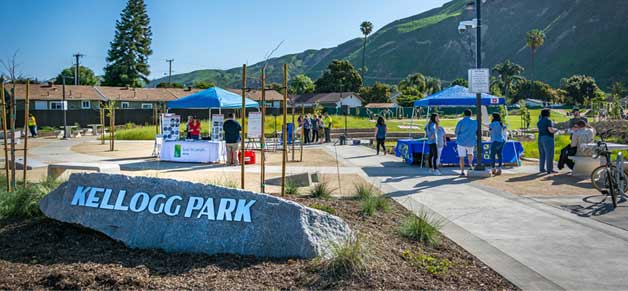It’s been eight years since Community Partners joined with Southern California Kaiser Permanente Community Benefits to help lead the funder’s ambitious HEAL Zones place-based initiative. In an effort to make healthy food choices and physical activity “the easy choice” for low-income families, the initiative developed and engaged coalitions of community-based organizations, local government agencies, schools, businesses and churches at each site. It also placed a strong emphasis on environmental and policy change by engaging local residents and developing their leadership capacity and ability to advocate for improvements in their communities.
Working closely with Kaiser and the Center for Community Health and Evaluation to manage the initiative was Community Partners Senior Program Director Judy Harper and Arpine Shakhbandaryan, senior program manager. They helped to build a peer learning network among residents and coalition staff, offer training in advocacy and community engagement, and provided tailored support to each site — including coaching, strategic counsel, meeting facilitation services, and training workshops – all to strengthen the ability of all those involved to drive environmental improvements and effect policy change in their communities.
And changes have been made. New parks were built, like Kellogg Park on Ventura’s Westside, a project that was spearheaded and driven by residents fed up with the lack of green space in their neighborhood. Children now climb and enjoy newly installed play equipment while adults and youth grow healthy, organic vegetables and flowers on community garden plots. A lighted crosswalk was installed at the urging of community members to ensure safe access to the new park.
On the east side of Riverside, alleyways behind homes once neglected and unappealing have been transformed into inviting walkways brightened with murals and re-engineered for foot traffic. Youth and adult residents lead the effort, securing buy-in from homeowners for murals on their alley-facing garages, spurring City Public Works Department to establish one-way traffic and inclusion of a broad walking path on the alleyways, and successfully requesting the allocation of funds for lighting and other improvements from the local city council. From places that were dangerous and ugly, the art-filled alleys and re-designed streets now provide safe-access corridors to and from schools, neighborhood markets and recreational centers.
And in the center city area of Ontario, a major transformation is underway. Building on a foundation of HEAL Zone “health hubs” (easy-access centers for physical activity and healthy food), the residents advocated for and secured City land for the community-directed Huerta del Valle urban farm, for the employment of local fitness class instructors at City recreation centers, and for City Council commitment to a Healthy Ontario. The sustained community resident advocacy with City and State elected officials, public agency staff and local schools eventually landed the City a $32 million Transformative Climate Community (TCC) grant from the state Strategic Growth Council. Building on this significant investment of state “Cap-and-Trade” funds, matched by local and federal grants, the downtown area of Ontario will become a green oasis where the healthy choice is the easy choice for low-income families.
As the initiative comes to a formal close this month, we’ve asked Judy Harper for her key takeaways.
“Really, it all comes down to the people — the residents who were involved with HEAL in their communities — and the strength of their relationships with each other, their connectedness. While it’s difficult to measure “social connectedness” and “civic engagement”, in the end that’s what will determine whether or not these changed environments and policies will lead to changed behaviors!
I know the residents really appreciated Kaiser’s willingness to listen to them and be flexible. Kaiser Permanente staff provided incredibly valuable opportunities for local residents to develop their leadership skills. They really learned how to advocate. Part of the legacy of this program, even after the funding ends, is that the residents are involved in both HEAL-related activities as well as many other things going on in their communities. This kind of work really results in greater civic engagement.
Our final Learning Community took place in Pasadena earlier this year. It was bittersweet, as we knew that this would be the last time that we would come together from across Southern California with a commitment to making the healthy choice the easy choice. We did, however, all depart with the knowledge that we have established roots on strong foundations and that the HEAL Zones will continue to thrive and serve as examples to other communities wishing to commit to our vision of health and well-being for all.
Join our mailing list!
Keep up on the latest from Community Partners—our partnerships, learnings, grant opportunities, resources and more.




